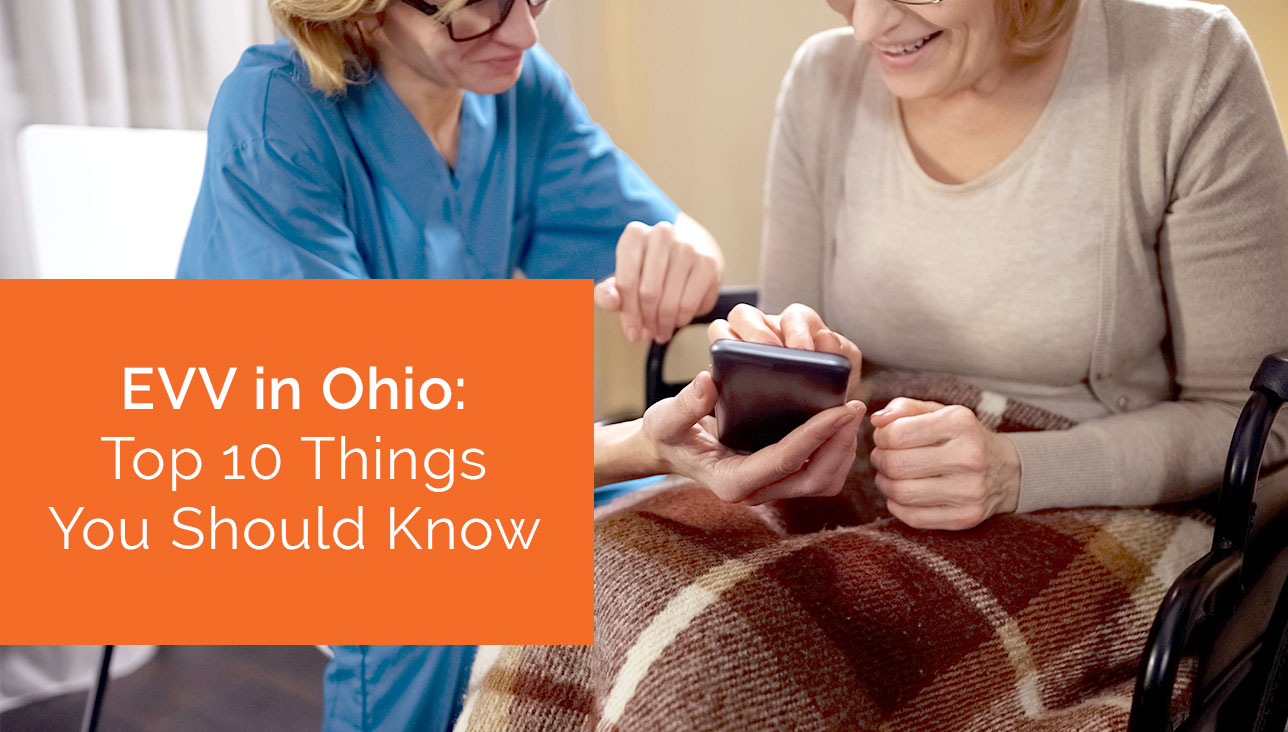1. What is EVV and Who needs to use it?
EVV stands for Electronic Visit Verification, which is a system for recording home-based personal care and home health services in order to confirm key details about those services. The adoption of EVV is mandated by the 21st Century Cures Act, but the specifics for how EVV is implemented varies state-by-state. In Ohio, there are two sets of rules related to what data you need to capture.
Ohio Ruleset #1 Applies To:
- Medicaid (known as fee-for-service):
- State Plan Home Health Services
- Ohio Home Care Waiver Services
- Managed Care Organizations
- Ohio Department of Aging
Required Data Capture:
- GPS coordinates—to show where the caregiver was located when they clocked in
- Client Signature—the client will sign on glass that they received the service or if using telephony will capture a voice recording
- When the service was provided, who provided the service, who received the service, what service was provided
- Client’s 12 digit Medicaid ID (unless Client is a Newborn and Medicaid ID is pending), or if Client is under the Ohio Department of Aging then a 7 digit PIMS ID is accepted.
Ohio Ruleset #2 applies to:
- Department of Development Disabilities
Required Data Capture:
- GPS coordinates—to show where the caregiver was located when they clocked in
- NOT REQUIRED: Client Signature—the client will sign on glass that they received the service or if using telephony will capture a voice recording
- When the service was provided, who provided the service, who received the service, what service was provided
- Client’s 12 digit Medicaid ID (unless Client is a Newborn and Medicaid ID is pending)
- For agencies providing care that falls within the rulesets above, there are a couple of options for how to capture and submit the visit data to Ohio. Ohio is an open state for EVV, which means that there is an EVV system provided by the Ohio Department of Medicaid (ODM), but that service providers are permitted to choose an EVV software vendor. However, the vendor must be approved by the state of Ohio. This means they have completed the requirements laid out by the state as well as successfully tested sending data to the state aggregator using their software solution with an Ohio Provider Agency, and received back production credentials for that provider.
- The ability to compare and choose your EVV vendor is a benefit that not all states will have, but it is important to ensure that your alternate EVV vendor connects properly with ODM. When choosing your vendor, ask them to explain to you the types of data they capture at the visit, and how they handle the various rules. Also, ask for a reference from the agency they worked with to get approved, so you know how it is going and can confirm the successful transfer of data.
2. Timeline
In Ohio, the implementation of EVV was broken into three phases. In Phase 1, providers began actively using an approved EVV solution for Medicaid Fee-for-Service. In Phase 2, this extended to require EVV for MCOs, DODD, ODA and Group visits. Also, in Phase 2 there were updates to rule logic and the data requirements were adjusted.
Ohio is currently in Phase 2 and waiting for the “Edit Disposition Set to Deny” date.
Phase 3 expands to include self-directed services and other services not yet met by Cures Act requirements.
Alternate EVV vendors are following an additional timeline as part of the overall phases. Getting approved by Ohio is a lengthy process, but an important one for providers.
3. Caregiver Engagement
Once in place, it is important that the EVV solution you provide to your caregivers is not only compliant but easy to use. After all, many caregivers will be using it daily, and the positive experience of your clients depends on it as well. When comparing EVV vendors, consider whether their EVV solution has training and onboarding that will be easy to complete. Can caregivers complete all of their care plan documentation from a mobile app, or is another device needed? Do you have a way to offer them shifts within the app without calling them? A solution with push notifications when an open shift is available makes filling shifts easier for caregivers and administrators alike.
When it comes to weighing convenience and ease of use, consider solutions that will avoid a trip to the office to turn in paper timesheets, for example. All experience improvements for the caregivers will incentive them to use the EVV solution, which in turn helps to ensure compliance.
4. Care Plans, Tasks, Service and Procedure Codes
Care Plans or paraprofessional assignment sheets are made up of tasks that pertain to a particular service or procedure code, discipline and even time of day. Not all mobile EVV solutions display care plans and tasks, and some may not permit multiple care plans to be displayed on the same shift.
Although Ohio does not currently require sending individual tasks as part of EVV, you do need to translate your services, payers and programs to the approved Ohio procedure code, payer and program. For example, what you call “home making” in your scheduling system translates to “S5125.” Ask your vendor for their approach in helping you translate or cross-reference to these payer/program/service code terminologies.
5. Flexible Documentation Format
One of the big benefits of moving to a mobile app that meets EVV requirements is the elimination of time-consuming (not to mention error-prone) paperwork. However, there are times when having a printed record may still be necessary for your business procedures, or even required in the case of surveys and audits. With that in mind, when selecting an EVV vendor and solution, ask to see a sample of the other ways that the visit information can be accessed and in what formats. In this example, all of the key information captured in EVV is also available in a printable format.
6. Exception Handling
When an aspect of the services captured by EVV doesn’t fully meet the requirements set out by the ODM rules, it is critical that you know when it has happened (and why) in order to resolve the issue in order to be paid for the services. This is called an exception, and while there are many reasons why one may occur, having visibility into the reason and tracking the resolution of it using the appropriate ODM reason code is key.
7. Payer Changes, Service Changes
As the regulations have made clear, EVV data is expected to be thorough. That means if there was an exception that has been corrected, the information surrounding that change is expected in order to accept the correction. This is called a Change Detail record, and there are many cases where it may be needed.
8. Frequencies in Data Flow
Alternate EVV vendors in Ohio are required to transmit visit data “at least daily,” so information flows to the aggregator within 24hrs of being created, and every 15 minutes upon a series of changes:
- Patient is new or updates made to demographics or payer information
- Caregiver is new or demographics are updated
- Visit is scheduled for a patient and assigned to a caregiver
- Visit date/time is adjusted
- Visit service is adjusted
- Visit is verified (all exceptions resolved)
- Visit is manually verified (all exceptions resolved)
9. Revenue Cycle—How Does This Impact My Billing?
To avoid any issues with your billing, you will need to ensure the data sent to your aggregator matches your claim file. Claims for the above payers require the addition of an NTE segment that contains the Service Date and Time, or when the caregiver punched in and out. When the claim is submitted for payment, the payer can audit against the aggregator to determine a match. If the payer cannot find a match the payment could be denied. (Claims acceptance can be a much bigger issue than EVV technology alone—hear about how to navigate billing and claims filing among all major payers, as well as how to handle EVV, in this recent webinar.)
10. Penalties/Denial
The Center for Medicare and Medicaid Services (CMS) has laid out the penalties for the next several years, should states fail to meet Cures Act requirements within the deadlines. States that do not comply with the Cures Act will have their Federal Medical Percentage (FMAP) reduced by increasing rates of reduction per year. The chart below outlines the FMAP reductions by year.
For more information, visit the Ohio Medicaid site. To learn more about the best certified alternate EVV solution in Ohio, discover ContinuLink Mobile Edge.




